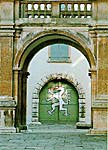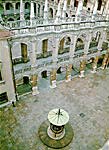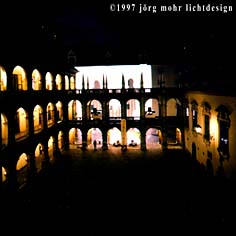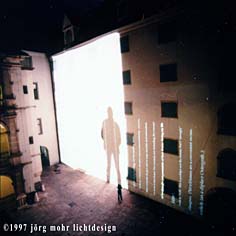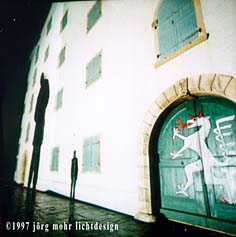During the third international Film + Arc Biennale in Graz, Austria, a Relational Architecture piece transformed the courtyard façade of one of Europe's largest military arsenals, the 350 year old Landeszeughaus. "Re:Positioning Fear" used a web site, webcam, 3D trackers, and customized projection technology to connect a very specific instance of Austrian history and architecture with remote and local participants.
The piece was loosely based on the Cathedral's fresco "the Scourges of God", which depicts the three Medieval fears of the people of Graz: the locust plague (which destroyed the fields in 1477), the Black Death (an epidemic that fortunately never had a devastating outbreak in Graz), and the fall of the city to Turkish invaders (which never happened). The fresco, which shows the oldest view of the city, has been ruined by inclement weather and incompetent restoration attempts, but is survived by a reproduction which can be seen at the Landeszeughaus.
Using the fresco as a departure point, "RE:Positioning Fear" related several historical transformations and displacements of Fear, particularly as parts of the world enter a post-industrial, post humanist era.
Re:Positioning Fear had two components:
![]()
A program of Internet Relay Chat (IRC) sessions discussing salient "contemporary fears". The IRC sessions featured artists, theorists and critics from all over the world. For a full listing of participants please follow this link.
There were eight sessions with loose thematic backing:
FEAR AT THE END OF GEOGRAPHY - delocality; cultural tectonics; border wormholes; tourist clones; telepresence; refugees and refusées. FEAR AT THE END OF BIOLOGY - body DJs; human genome and other endotaxonomies; microbesoft and biotrademarks; dividuals.
FEAR AT THE END OF ART - We tried, we failed; retrofunding; the search for otherception.
FEAR AT THE END OF ECONOMICS - market correctness; market police; market violence; market envy.
FEAR AT THE END OF ARCHITECTURE - vampire buildings; special effects home; architact; site-specific isn't; the internal exterior; domesticity. FEAR AT THE END OF TECHNOLOGY - microsoft; baby walkmans; persistance of the humanist cyborg; all intelligence is artificial.
FEAR AT THE END OF THE INTERNET - zero tolerance webmasters; cibernating; "net-set" blood; bandwidth denial; the resistance of content.
FEAR AT THE END OF "THE END" - paranoia and postnoia, St Augustin, apocalapsus, nanohope.

During the Film+Arc Festival, the IRC sessions were projected in real-time on the Zeughaus arsenal's courtyard facade; two Barco 9200 projectors covered a total area of 15 x 20 metres. The building was thus taken over by a deterritorialized, decontextual dialog or "source code". A webcam captured the event every second and allowed the internet participants to see their contributions as they appeared on the building.
The IRC sessions reflected on contemporary fears as decentered, distributed phenomena or "syndromes" more than invasions: global warming, AIDS, terrorism, economic violence, surveillance society, genetic tampering, refugees, etcetera. This mirrored the nature of IRC text which does not have a clear textual "backbone" but it is rather composed of textual "ribs". The proceedings of the IRC sessions, in the form of slightly-edited logs, can be found in the "Re:Positioning Fear" repository, where participants also submitted notes, quotes, and other texts that anchor the discussion on FEAR from the realm of the abstract to very specific instances within geopolitical, architectural, philosophical, biological, etc discussions. (The repository also contained the webcam view of the building as it was transformed during the piece).
![]()
Even though the IRC sessions could have been projected on the arsenal by covering most of the facade, an interface was designed to prevent all of the text to be visible at one time. The interface is called "tele absence" and it consists of an "active" shadow that reveals the text on the building. To read the building, a participant standing in front of it must wear a small wireless sensor and walk around the courtyard. As he or she walks, two pigi 7kW Xenon light sources track his position and project his shadow onto the facade of the Zeughaus. By using robotic lighting control, the shadows were focused dynamically so that regardless of the participant's proximity to the lamps the shadows were always crisp and well defined. The final effect was a "dynamic stencil" whereby the shadow of the participant was an active architectural element which "revealed" the IRC texts that appeared to be within the building, as though the shadow was a cutout or an x-ray of the building.
tele-absence interface, concept sketch 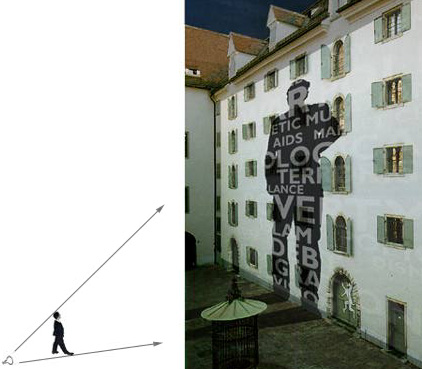
"Tele-absence" is defined as the technological acknowledgement of the impossibility of self transmission. Tele-absence is a celebration of where and when the body is not. The shadow is not an avatar, an agent, nor an alias of the participant's body, it is projected darkness, a play of geometries, a disembodied bodypart. Just as contemporary physics has discovered that a vacuum is indeed a place with intense quantum mechanical activity, here the shadow, a supposedly immaterial form created by the absence of light, becomes a site of telematic activity.
tele-absence interface 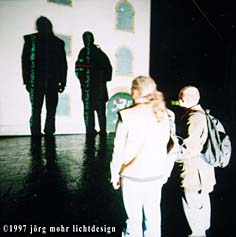
As it travels over the building, the shadow was deformed by the windows and crevices of the facade as well as by the characteristics of the movements of the participant. This added to the anamorphosis of the projection and underlined the building's performative quality. By calculating when, where and how the shadow intersected the Zeughaus, the installation's computers triggered audiovisual events which used the texts contributed by the people on the IRC sessions. The piece emphasized the fact that the shadow is formed by a collaboration between the light, the building and the participant.
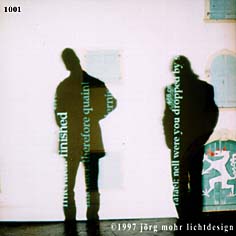
A shadow interface can be interpreted to be a metaphor of the obliqueness of ancient (and contemporary?) threat. The Zeughaus itself was built out of fear of the expansionist Turks: yet their looming presence was felt only as a shadow, as they never entered Graz. Here, the Zeughaus became a repository that performed the transformation and the repositioning of the fears.
The arsenal has appropriate dimensions, history and aesthetics for the piece, particularly considering it is now a public museum, where fear and paranoia have become tourism and postnoia.
the Landeszeughaus (arsenal) courtyard in Graz 
